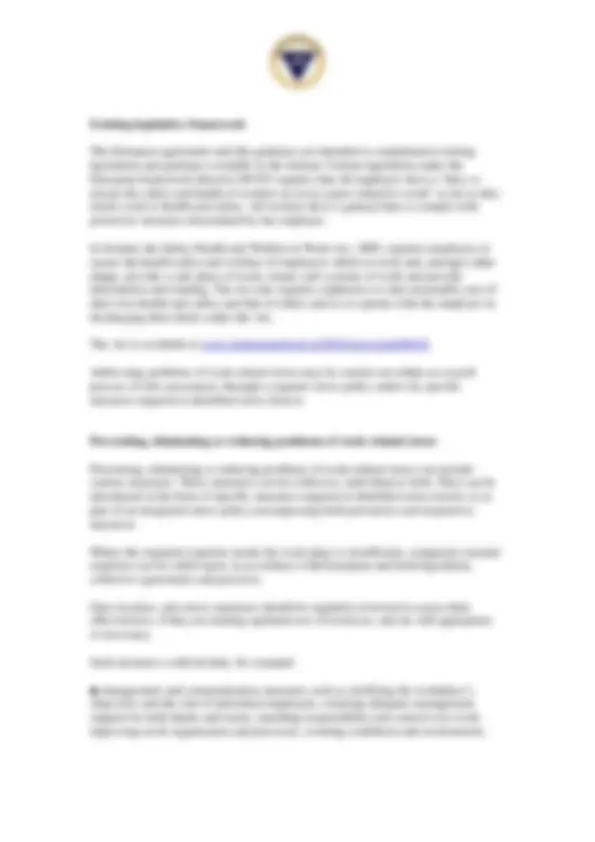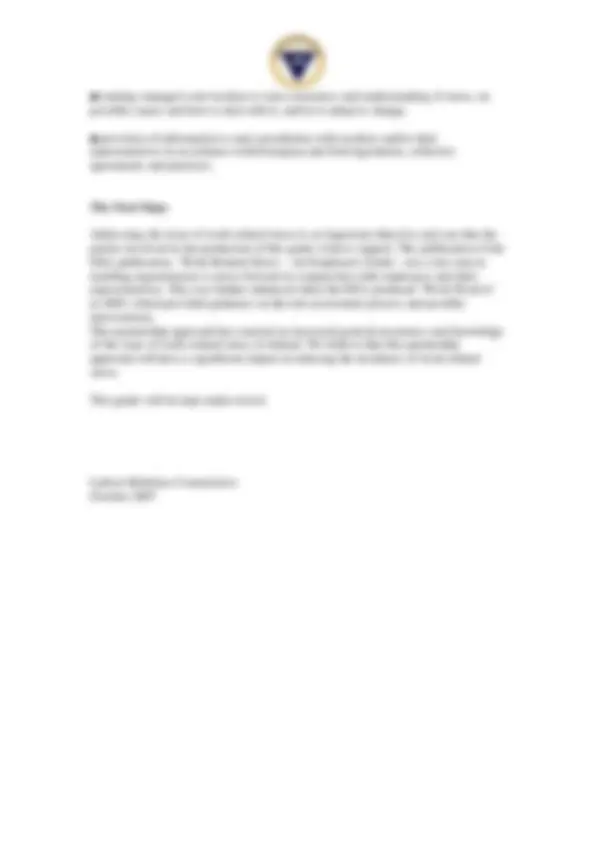




Study with the several resources on Docsity

Earn points by helping other students or get them with a premium plan


Prepare for your exams
Study with the several resources on Docsity

Earn points to download
Earn points by helping other students or get them with a premium plan
Community
Ask the community for help and clear up your study doubts
Discover the best universities in your country according to Docsity users
Free resources
Download our free guides on studying techniques, anxiety management strategies, and thesis advice from Docsity tutors
A guide by the labour relations commission in collaboration with ibec and ictu to increase awareness and understanding of work-related stress in irish workplaces. It provides an overview of the definition, identification, and prevention of work-related stress, as well as existing legislative frameworks and measures to address the issue.
What you will learn
Typology: Exercises
1 / 4

This page cannot be seen from the preview
Don't miss anything!



This guide has been drawn up under the auspices of the Labour Relations Commission and in conjunction with the Irish Employers confederation (IBEC) and the Irish Congress of Trade Unions (ICTU). The guide implements into an Irish context the European Social Partnership agreement on stress (in the context of its work programme on social dialogue 2003 – 2005).
Work related stress has been identified generally both in Ireland and at international levels, as a significant concern for both employees and employers. Stress can potentially affect any workplace, small or large in any field of activity, and can affect any employee irrespective of what form the employment contract or relationship takes.
The parties to this guide are strongly of the view that it is vital that stress in the workplace be managed effectively to minimise negative impacts on the individual employee, employers and the Irish economy generally. Tackling stress at work has a number of potential benefits including greater efficiencies, positive economic and social benefits for workplaces and employees, improved occupational health and safety and a positive work environment generally.
This Guide seeks to:
The objective is to provide employers and employees with a framework to identify and prevent or manage problems of work-related. It is not about attaching blame to the individual for stress. Under the agreement, the responsibility for determining the appropriate measures rests with the employer. These measures are carried out with the participation and collaboration of workers and/or their representatives. These measures can be collective, individual or both. They can be introduced in the form of specific measures targeted at identified stress factors or as part of an integrated stress policy encompassing both preventive and responsive measures.
This guide does not cover violence, harassment or post-traumatic stress which will covered by another social dialogue agreement dealing specifically with these issues.
Definition of stress and work related stress
Stress is a state, which is accompanied by physical, psychological or social complaints or dysfunctions and which results from individuals feeling unable to bridge a gap with the requirements or expectations placed on them.
The individual is well adapted to cope with short-term exposure to pressure, which can be considered as positive, but has greater difficulty in coping with prolonged exposure to intensive pressure. Moreover, different individuals can react differently to similar situations and the same individual can react differently to similar situations at different times of his/her life.
Stress is not a disease but prolonged exposure to it may reduce effectiveness at work and may cause ill health.
Stress originating outside the working environment can lead to changes in behaviour and reduced effectiveness at work. All manifestations of stress at work cannot be considered as work-related stress. Work-related stress can be caused by different factors such as work content, work organisation, work environment, poor communication, etc.
Identifying problems of work-related stress
Given the complexity of the stress phenomenon, this guide does not intend to provide an exhaustive list of potential stress indicators. However, high absenteeism or staff turnover, frequent interpersonal conflicts or complaints by workers are some of the signs that may indicate a problem of work-related stress.
Identifying whether there is a problem of work-related stress can involve an analysis of factors such as work organisation and processes (working time arrangements, degree of autonomy, match between workers skills and job requirements, workload, etc.), working conditions and environment (exposure to abusive behaviour, noise, heat, dangerous substances, etc.), communication (uncertainty about what is expected at work, employment prospects, or forthcoming change, etc.) and subjective factors (emotional and social pressures, feeling unable to cope, perceived lack of support, etc.).
If a problem of work-related stress is identified, action must be taken to prevent, eliminate or reduce it. The responsibility for determining the appropriate measures rests with the employer. These measures will be carried out with the participation and collaboration of workers and/or their representatives.
■ training managers and workers to raise awareness and understanding of stress, its possible causes and how to deal with it, and/or to adapt to change,
■ provision of information to and consultation with workers and/or their representatives in accordance with European and Irish legislation, collective agreements and practices.
The Next Steps
Addressing the issue of work-related stress is an important objective and one that the parties involved in the production of this guide wish to support. The publication of the HSA publication, ‘Work Related Stress – An Employers Guide’, was a key step in enabling organisations to move forward in conjunction with employees and their representatives. This was further enhanced when the HSA produced ‘Work Positive’ in 2005, which provided guidance on the risk assessment process and possible interventions. This partnership approach has ensured an increased general awareness and knowledge of the issue of work-related stress in Ireland. We believe that this partnership approach will have a significant impact in reducing the incidence of work-related stress.
This guide will be kept under review
Labour Relations Commission October 2007